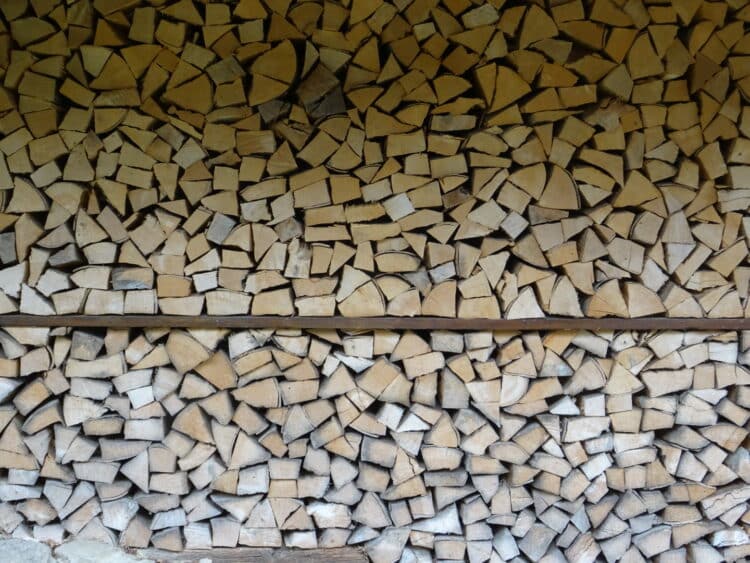
After you manage to split firewood with a chainsaw, the next order of business is knowing how to stack firewood for proper storage.
This is probably the most satisfying parts of cutting and organizing your own firewood. There’s no real danger brought on by chainsaws and sawing through wood.
It’s just you and the huge piles of firewood you have to sort through to make a satisfying stack.
With enough patience, you will soon be able to feel the satisfaction roll through you whenever your stack of firewood catches your eye.
One of the purposes of stacking firewood is allowing it to dry thoroughly in a process called seasoning. There has to be enough space in between the wood to allow breezes to pass through.
Ensuring your wood is well-seasoned means you get the maximum benefits of it burning. It won’t require as much attention as you try to light it, and it is environment friendly.
There are a lot of strategies for stacking wood in favor of them drying out well enough. You just have to find the right one that suits you and your home.
This article will detail a few options on how to stack firewood, as well as other relevant things you need to know when it comes to firewood in general.
Table of Contents
Do I need a chainsaw to cut firewood?
A chainsaw comes highly recommended because it makes your life so much easier. You finish splitting all your wood faster, and there’s less exertion on your part.
Your chainsaw’s size greatly affects what size firewood you are going to be using. It should be about two inches longer than your intended firewood length.
But if you want to go the old, traditional route of using an axe, then go right on ahead.
How do I know my wood is well-seasoned?
Well-seasoned wood is firewood that is left with 20% moisture content. This is usually figured out depending on its weight.
Most firewood is left to season for months, since they are usually split in the spring in preparation for winter.
Here are a few qualities of well-seasoned wood:
1. It does not have a woody smell.
This kind of smell is brought on by moisture so if you’re wood smells like wood, it probably isn’t well-seasoned.
2. It looks grayish.
Wood that has been left out to season well does not look like it originally did because most of the moisture has left it.
3. It is light.
Wood is three quarters full of water. A well-seasoned piece of wood has lost most of its moisture and only has about 20% moisture left.
4. It is brittle.
You can see this from the way the ends crack once the wood dries up.
5. The bark slides off easily.
As moisture leaves the piece of wood, the bark usually follows next. An even better sign is when there is no trace of the bark at all.
6. It creates a hollow sound.
When you tap it or lightly hit it against something, it will sound hollow. Again, this is because it has lost most of its moisture.
Why is it so important to stack firewood?
Well-seasoned firewood ensures it will burn to the best it can once it is used as kindling for a fire. Stacking firewood contributes to the seasoning of a piece of firewood.
In order for it to lose most of its moisture, the firewood has to be arranged in a way that exposes it to the sun and the air. These two factors allow it to dry naturally over the course of a few months.
If you stack firewood the wrong way, it could become either too wet or too dry for use.
Wet firewood takes longer to light and creates more smoke than necessary. Firewood that is too dry, which means it has less than 20% moisture, will burn too fast and you are going to run through your supply of firewood really quick.
What are the basic principles of stacking firewood?
Before you actually get to stacking your firewood, there are several factors you will have to consider:
1. Location is important
You can’t just pile up your firewood in a random location and call it a day. You need to find the right location to place them that keeps them safe from wildfires, insects, etc.
Sun exposure
You need to look for a location that is regularly exposed to the sun. Since firewood is usually split during the spring, it will have time to dry during the summer in preparation for winter.
Wind direction
On top of sun exposure, your firewood has to be horizontally angled in a way that the wind can rush through it from end to end. The better the air circulation, the better it dries.
Letting them face east to west is recommended because the sun and wind can get through to them from end to end.
Avoid putting it too close to your house
If you live in an area that is prone to wildfires, you need to keep the stack away from your house. The recommended distance is 30 feet away.
But if your area is not prone to wildfires, you can get away with stacking them a little closer away. 5 feet is a good distance minimum just in case any insects start eating away at your stack.
Keep away from playgrounds
Children and dogs can easily topple the stack if it’s not sturdy enough, and especially if anyone decides to climb on top of it.
Keep your stack in a location that prevents it from being disturbed.
2. Don’t let it touch the ground
There are a few problems that come with letting your firewood stack touch the ground. You need to be aware of them to avoid them:
Little to no airflow
The bottom-most part of the stack won’t be able to get the airflow it needs to effectively dry up. Instead, it will remain wet.
More moisture
Your end goal is to dry the stacks out, not let more moisture get into them. Moisture can travel from the ground and to your wood.
It even gives way for more problems because moisture is a favorite place for mold and decay to thrive. This means you won’t be able to use your firewood for burning.
Invites insects
Allowing firewood to touch the ground means you give insects easy access into your firewood. Insects like termites love wood.
You might even bring in wood that has termites in it into your home, and this could lead to them spreading under your foundation as they try to eat up all the wood they come into contact with.
There are a lot of ways you can use to prevent your firewood from touching the ground. One of the most common ways is simply using a firewood rack.
Or, if you won’t be able to use a firewood rack, you can place it on the ground as long as the ground is covered by a natural drainage such as gravel.
Other materials such as brick, stone pads, and concrete also works. But if there is no other option, lay the firewood bark-facedown to keep as much moisture out as possible.
3. Put something over it to keep it dry
No use seasoning your firewood for months only for it to regain moisture through rain. Keep it dry by covering it with a tarpaulin. Don’t cover the entire stack completely because this invites moisture instead.
You can simply cover the top of the wood to allow wind to still breeze through your stacks, and for rain to slide off the sides. This is recommended because it can still allow your firewood to catch up on drying time.
Another option is using a woodshed to keep your firewood dry, but still let airflow pass through your pieces of wood.
4. Don’t throw them into a haphazard pile
Green wood, or rather wood that has not dried yet is caused by a pile that was not stacked properly. It has the added consequence of leaving creosote buildups inside your chimney.
If you are unaware of this buildup, you may fall victim to a chimney fire. Here are a few tips on stacking firewood:
Do not pack firewood tightly
You want loosely packed firewood. Your goal is not to save space, but to have firewood with proper airflow running through as much sides as possible.
Expose the ends that were cut
When you stack firewood, make sure that the cut ends are exposed to open air. This is where wood usually releases moisture.
How to stack firewood?
There are several methods for stacking firewood. Each may be suited for different types of land or personal preference.
Remember to factor in location and ground contact because they are the most important factors to consider when stacking firewood.
1. Between pillars
For this method, you will have to create your own firewood pillars before filling in the firewood in between.
First, lay down about three to four firewood pieces beside each other. Next, follow it up with another three to four pieces, this time facing the opposite direction.
Continue doing this until there are twelve rows of firewood stacked on either end. It’s like playing Jenga, but you are using firewood instead of Jenga blocks.
After creating your pillars, start stacking rows of firewood between them both. As you’re stacking the second layer of firewood, remember not to pack them tightly.
You still want good airflow to rush through them so that they can dry evenly. Pack them loosely instead.
While you’re stacking, be sure to stack your firewood with the bark facing up so that it is protected from rain. But if you have no choice but to place them directly on the ground, Put the bark facing down.
2. Pillars only
Instead of just building two pillars and filling them out with firewood in between, this method involves using pillars only. This way, you will get a few dozen or so pillars of firewood.
You start the same way you did in the previous method by laying down three to four firewood pieces beside each other. Follow it up with another three to four pieces, this time facing the opposite direction.
Continue doing this until there are twelve rows of firewood, forming one pillar. Repeat this process again a few inches away from this pillar.
Make sure there is enough space in between pillars for good airflow between each firewood stack.
3. Holz Hausen
The Holz Hausen method is a way of stacking firewood that doesn’t take as many rows of space.
Its intended goal is to lessen the use of space and create satisfying firewood piles that go in circles. This method is highly recommended for use in sunny locations to maximize drying and sun exposure.
First, establish a protective base in the shape of a circle or ring on the ground. Next, lay down a ring of wood horizontally around your circle.
Once you have a ring of firewood, it’s time to get started on the next row. This time, you will have to position your firewood so that one end is on the first row, and the other end is sloping down towards the inside of your circle.
Complete this second row of firewood. Repeat this process until you have a total of seven rows including the ring of firewood at the bottom.
On top of your seventh row, place another horizontal ring of firewood (the same as your first row) around the entire stack. This makes the eighth row of firewood.
Repeat the process, placing a horizontal ring of firewood after every sixth stack of sloping firewood until you have about three of these horizontal rings, and have about eighteen rows of firewood.
You can place some firewood to fill out the center of the ring, or leave it hollow so that rain can easily drain through the center.
Cover up the firewood with a tarpaulin.
Conclusion
You are free to choose which firewood stacking method suits you best. As long as you get the factors such as sun exposure and airflow right, then it should season your firewood nicely.
Now that you know how to stack firewood, enjoy the satisfaction of looking at your woodpile every morning as you wake up.


